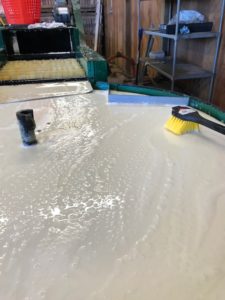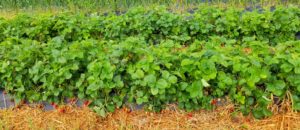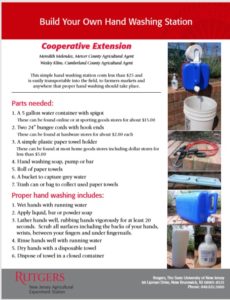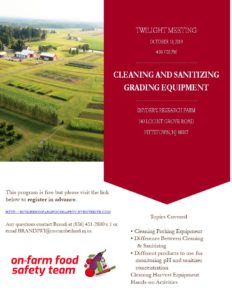Providing handwashing opportunities for customers and those working on the farm is considered a best practice in reducing human pathogen risk. Handwashing stations can be portable and inexpensive. Click on the picture below for one example of an easy to make handwashing station:
On-Farm Food Safety Section
Keep up with the latest news on this dynamic topic that impacts growers on multiple levels. Developing a farm food safety plan is a good idea for all growers, and may be required as part of food safety audits if you sell to certain buyers.
View NJAES On-Farm Food Safety Essentials
Your Produce Operation and COVID-19 Concerns
COVID-19 has farmers questioning what they need to do to protect their customers, and businesses. The University of Vermont has published useful information for produce growers on best practices for surface sanitation and hygiene.
Considerations for Fruit and Vegetable Growers Related to Coronavirus & COVID-19
Evaluating postharvest cleaners, sanitizers, and surfaces
 GAPs, third-party audits, and the FSMA Produce Safety Rule have a heavy focus on the cleaning and sanitation of surfaces that come in contact with produce. These surfaces can be harborage points for pathogens that are problematic for those that consume them, and for decay organisms that shorten your crops shelf life and marketability.
GAPs, third-party audits, and the FSMA Produce Safety Rule have a heavy focus on the cleaning and sanitation of surfaces that come in contact with produce. These surfaces can be harborage points for pathogens that are problematic for those that consume them, and for decay organisms that shorten your crops shelf life and marketability.
During the summer of 2019 we gathered a number of surface materials that are commonly used in packing houses, some of the surfaces are used as temporary fixes, others are for permanent use. Each of the surfaces was evaluated for cleanability and sanitation using common detergents and sanitizers. Swab sampling was used to assess “dirtiness” before cleaning, and then cleanliness after rinsing with water, after using a detergent, and again after using a sanitizer. We paid attention to how quickly the swab sampling numbers were reduced after each step.
What was abundantly clear was that the process is critical, no matter what detergent or sanitizer you use. The most effective process is:
1. Rinse all visible debris off of the surface with water
2. Use an appropriate detergent and scrub the surface, paying attention to all corners, crevices, joints, and screw/bolt heads
3. Rinsing the surface clear of detergent and dislodged debris
4. Use a sanitizer approved for food contact surfaces, follow the directions
Another common issue found was that visibly clean doesn’t necessarily mean that the surface is clean enough to use. Just rinsing off with water can remove visible debris, and reduced the swab sampling number, but not enough to be considered clean. This was consistent across all the surfaces we evaluated in the study. Surfaces evaluated included vinyl flooring, polyvinyl chloride (PVC), polypropylene (PP) surfaces, high density polyethylene (HDPE) tabletop, fiberglass reinforced panels (FRP), acrylic sheet (PPMA), styrene, extruded composite lumber (PET), wood surfaces, plastic household mats, and sheet metal painted with countertop paint. These surfaces were chosen for their ease of purchase locally and that many have been seen in use on farms across the state.
There are many sanitizers available on the market, including organic approved products. We evaluated chlorine, peroxyacetic acid, quaternary ammonium, and chlorine dioxide. All are labeled for use on food contact surfaces. Label instructions were followed and dip strips were used to ensure that the target PPM of each sanitizer was achieved. Using too little of a sanitizer is ineffective, and too much of a sanitizer can cause damage to the surface you are cleaning. Detergents evaluated were common dishwashing detergent, citric acid, ethoxylated coconut oil, and a foaming non-hazardous spray on detergent.
When the swab sampling numbers were evaluated we found that smooth surfaces cleaned the best and were more consistently sanitized. Surfaces with raised designs, grooves, or bumps did not have as significant reduction of swab sampling numbers as compared to the smooth surfaces. This inability to sanitize as effectively can allow for biofilms to form, providing a harborage point for disease. The surfaces that were most consistent in their ability to be cleaned and sanitized were fiberglass reinforced panels, commonly known as sanitary wall and often used in dairy milk houses, and extruded composite lumber. Surfaces painted with countertop paint did well initially, but repeated scrubbing allowed for scratches in the paint, and thinning of the surface over time. This resulted in a reduced ability to clean and sanitize effectively. Surfaces that consistently showed they were uncleanable were foil tape (sometimes used as a quick fix on surfaces), flexible plastic kitchen mats, uncoated wood surfaces, and vinyl flooring. All other evaluated surfaces had variations in the swab analysis results based on the detergent and sanitizer combinations. All detergents were effective at reducing the swab sampling numbers, with the foaming detergent having a more consistent effect over all of the surfaces tested. The sanitizers evaluated, when used according to product directions and on smooth surfaces, reduced the swab sampling numbers significantly.
Critical points to consider:
-Develop a regular cleaning schedule with a written standard operating procedure detailing the products used, how they are used, and the steps involved in cleaning and sanitizing the surfaces.
-Do a test run when you aren’t pressed for time, take apart equipment, determine if you have the right supplies, and estimate the time it will take to properly clean and sanitize the equipment.
-Remember that the beginning of the season cleaning and sanitizing procedure will likely be more detailed than a during the season cleaning.
-Provide training for the person/s, and their backup, who will be responsible for cleaning and sanitizing postharvest surfaces.
-Only use sanitizers that are approved for food contact surfaces, and follow the label directions.
-When fixing packing equipment only use surfaces that are smooth, do not absorb water, and have not been used for other activities at the farm that may pose a contamination risk.
-Avoid cracks and crevices on your postharvest surfaces, these are difficult to clean and sanitize.
-When gloves are used workers must be trained on how to use them so they do not become a contamination source.
-Remove surface moisture in the packinghouse/area whenever possible using squeegees and fans.
-Remove culls from the packing area daily so they do not become an attractant for wildlife.
-Utilize a pest control program in the packing and storage areas, focusing on rodents and other wildlife intrusions.
-Remove as much soil as possible from harvested produce in the field, rather than in the packing area.
-Use new containers or containers that can be cleaned and/or sanitized to pack and display produce.
-Storage areas and coolers should be monitored for cleanliness, and be included in the rodent control program.
Visit the Rutgers On-Farm Food Safety website for more produce safety resources.
This work funded by USDA Specialty Crop Block Grant #16-SCBGP-NJ-0046
Twilight Meeting 10/10: Cleaning and Sanitizing Grading Equipment
Join us at the Rutgers Snyder Research Farm to discuss the cleaning and sanitizing of produce grading equipment.
October 10, 2019 from 4:00 p.m. to 7:00 p.m.
This event is free but please register through Eventbrite or call Brandi at 856-451-2800
African Swine Fever
African Swine Fever (ASF) no longer dominates the headlines and Chicago traders seem to have tired of speculation as to when supply shortages will result in higher prices. And yet the disease continues to march through China and Southeast Asia, leaving behind an ever-expanding supply hole. Here’s where things stand at this point:
– The number of new cases of ASF reported in China has been minimal, with no cases reported last week and only a handful of cases reported in the last month. China is a member of OIE, the world organization for animal health, and ASF is a reportable disease. In other words, China is obligated to report any and all new cases of ASF when they occur. This is so other countries understand the scope of the disease and take measures to protect themselves. China announced earlier in the summer that they have put in place a very rigorous testing regime for ASF but it appears that the number of ASF cases in the country has declined following the implementation of this new system. But even as no new cases have been reported, Chinese authorities indicated that the Chinese hog breeding herd in July declined by a staggering 8.9% from the previous month. To reiterate, the breeding herd which in June we calculate at around 30.5 million head declined by some 2.7 million head. How did those sows disappear with just a handful of ASF cases reported and only hundreds of pigs destroyed in official reports?
– The Chinese total hog inventory in July declined by 9.4% and since the start of the year the total hog inventory has declined by about 100 million head. In July alone the inventory contracted by an estimated 31 million hogs, which is almost half of the overall inventory of hogs we have in the US. Please keep in mind that Chinese officials do not report actual numbers. Rather, they do a survey of various stations and report the m/m change. To come up with actual numbers we took the latest official reported statistics and calculated the change from that point on. For a while, the decline in inventory numbers did not appear to have much of an impact on prices. Indeed, the short-term effect of any liquidation is to depress prices. But there has been a significant shift in China pork price action. Last week the reference hog price in China was pegged at 20.9 yuan per kg. In USD this comes to $2.95/kg ($1.34/lb. live or $1.80/dressed). We think the average price for this week, based on daily numbers, will be around 23.6 yuan/kg. Always be careful when comparing US hog prices to prices in a different country, however. It is not apples to apples since hog prices in China are for a product that will be slaughtered and sold fresh in traditional markets that are highly valued. US product will be frozen, shipped a long distance and likely go into processing or be sold in supermarkets with a markup. Hog prices in China have jumped 30% since the end of July and they are currently 74% higher than year ago, surpassing the record price levels we saw back in 2016. Pork prices at retail have also started to escalate, a signal of developing pork supply shortages in the market.
– ASF is not an issue in China alone. Reports from Vietnam underscore the degree of devastation in that country. Different from China, Vietnam continues to report scores of new cases of ASF and according to FAO, some 4 million pigs have been culled out of a total inventory of about 26 million at the start of the year. Cases of ASF have also been reported in Cambodia, Myanmar and Lao. There have also been reports of increased mortality in pigs in the Philippines although no official confirmation of ASF yet. A large number of backyard farms and limited bio-security means that once the disease enters an area it is almost impossible to contain it.
– The disease also continues to impact countries in Eastern Europe, with Bulgaria and Serbia the latest countries to report new cases of ASF. Bottom line: Despite some ASF reporting fatigue, the disease is far from contained and will remain a market factor going forward.
This article is taken from the Daily Livestock Report, for a more complete analysis please see:
FSMA Produce Safety Rule Training 9/11/19 Ewing
Need a food safety education certificate for the FSMA Produce Safety Rule or for a buyer required third party audit? Join us!
September 11, 2019
Rutgers Cooperative Extension of Mercer County
1440 Parkside Avenue, Ewing, NJ 08638
9:00 – 4:00, lunch included
$50 covers the training, materials, certificate and lunch


